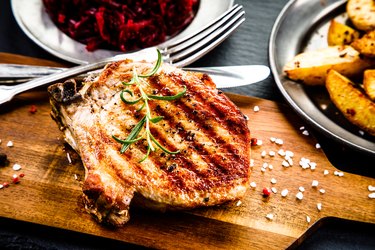
Using an oven bag allows you to cook foods without all of the mess from the pan drippings.
The heat-resistant bag catches the juices from the pork so they don't stick to your pan. With the drippings enclosed in the bag, the liquid does not evaporate. And because the meat cooks in its own juices, your finished loin is moist and tender rather than dry.
Video of the Day
Video of the Day
Any pork cut that you cook in the oven should work well in an oven bag, too. Before beginning, take the time to read through the instructions that come with the bag — manufacturers offer different ways to use the bag that will improve the final product and reduce incidents of breakage.
Things You'll Need
Pork
Oven bag ($13 per 3-pack, Amazon.com)
Large 2-inch-deep baking dish
Barbecue sauce
Salt
Pepper
Flour
Knife
Step 1: Preheat the Oven
Preheat the oven to 350 degrees Fahrenheit.
Step 2: Season the Pork
Season the pork as desired. Depending on the cut, you may want to marinate the meat prior to baking.
For example, if cooking pork ribs, brush barbecue sauce over the surface of the ribs. If cooking pork chops, add a sprinkle of salt and pepper.
Step 3: Add Flour
Pour flour or a flour substitute, like cornstarch, into the bag and shake it around to coat the interior. Follow the directions on the bag for the amount of flour to use. Some oven bags require at least 1 tablespoon of flour to absorb juices from the pork so the bag does not burst.
Cuts such as ribs might require additional flour because they are fattier.
Tip
Flour or a flour substitute is a key component for cooking pork chops or loin in a bag. The flour blends with the fat and juices in the oven bag to prevent the bag from bursting. Always pour about a tablespoon of flour or flour substitute into the bag prior to cooking, and then shake the bag to spread the flour around. If your recipe calls for a thickened sauce or gravy, you can add more flour as indicated.
Step 4: Put the Pork in the Bag
Place the pork into the bag and lay it inside a large baking pan. Use a dish that is at least 2 inches deep. The pan should allow the bag to expand as the meat cooks without any area touching the sides of the dish.
Step 5: Cut the Bag
Cut four to six slits in the top of the bag to allow for venting.
Step 6: Bake the Pork
Bake the pork according to the directions on the recipe. For example, cook pork ribs for 1 1/2 hours or bake chops for 25 minutes.
Make sure the pork loin reaches a safe internal temperature of 160 degrees Fahrenheit.
Tip
Choosing the correctly sized oven bag is essential. Pork loin ranges in size from 2 1/2 to more than 10 pounds and oven bags also come in different sizes. A small pork loin can cook in a large oven bag. For heavier cuts, use a bag designated for roasting turkeys ($10, Amazon.com).
When you set the roast in the bag, the fit should be roomy. The bags will expand while the pork cooks and moisture forms and the bag can't spread out if it is too small.